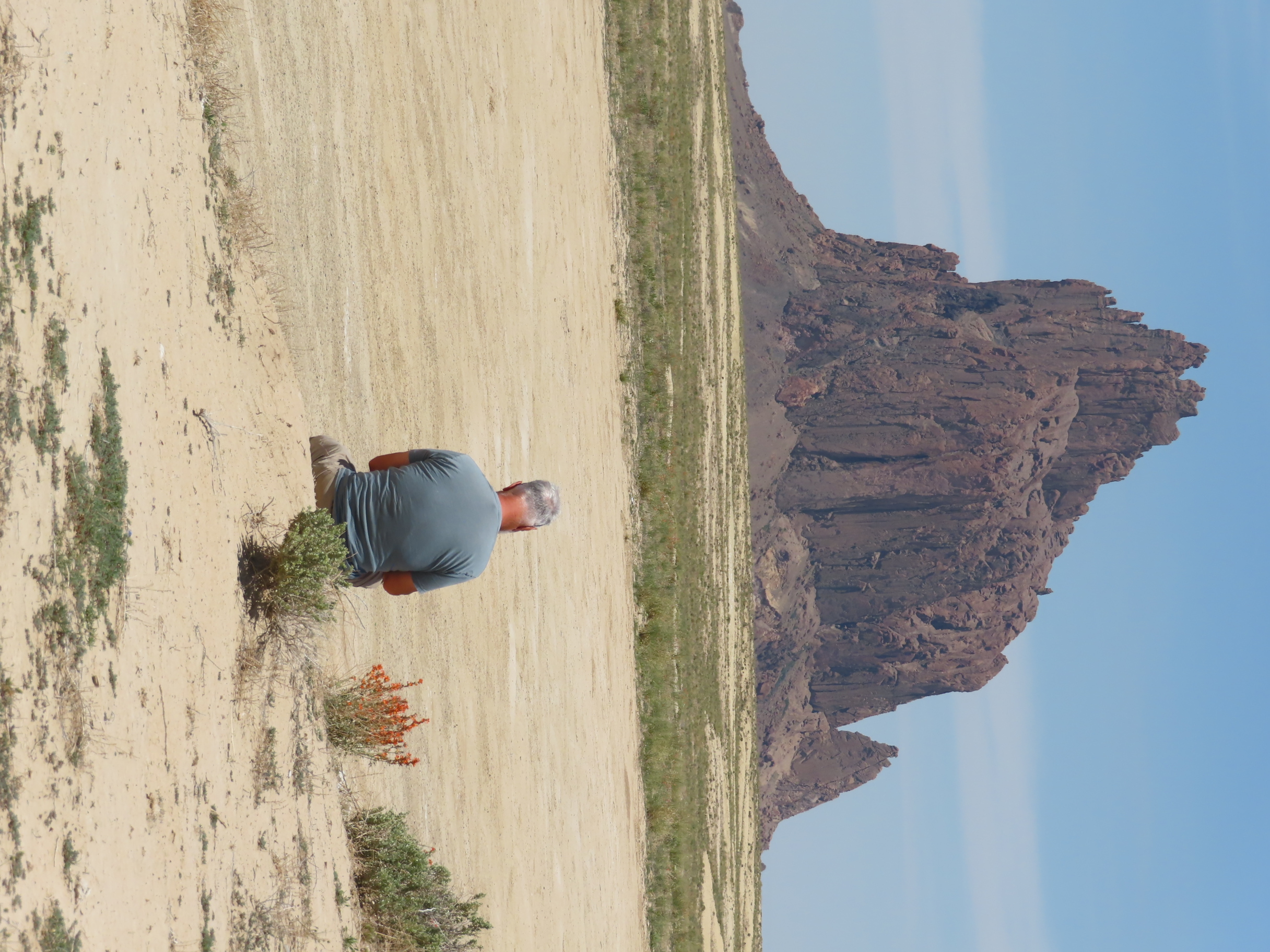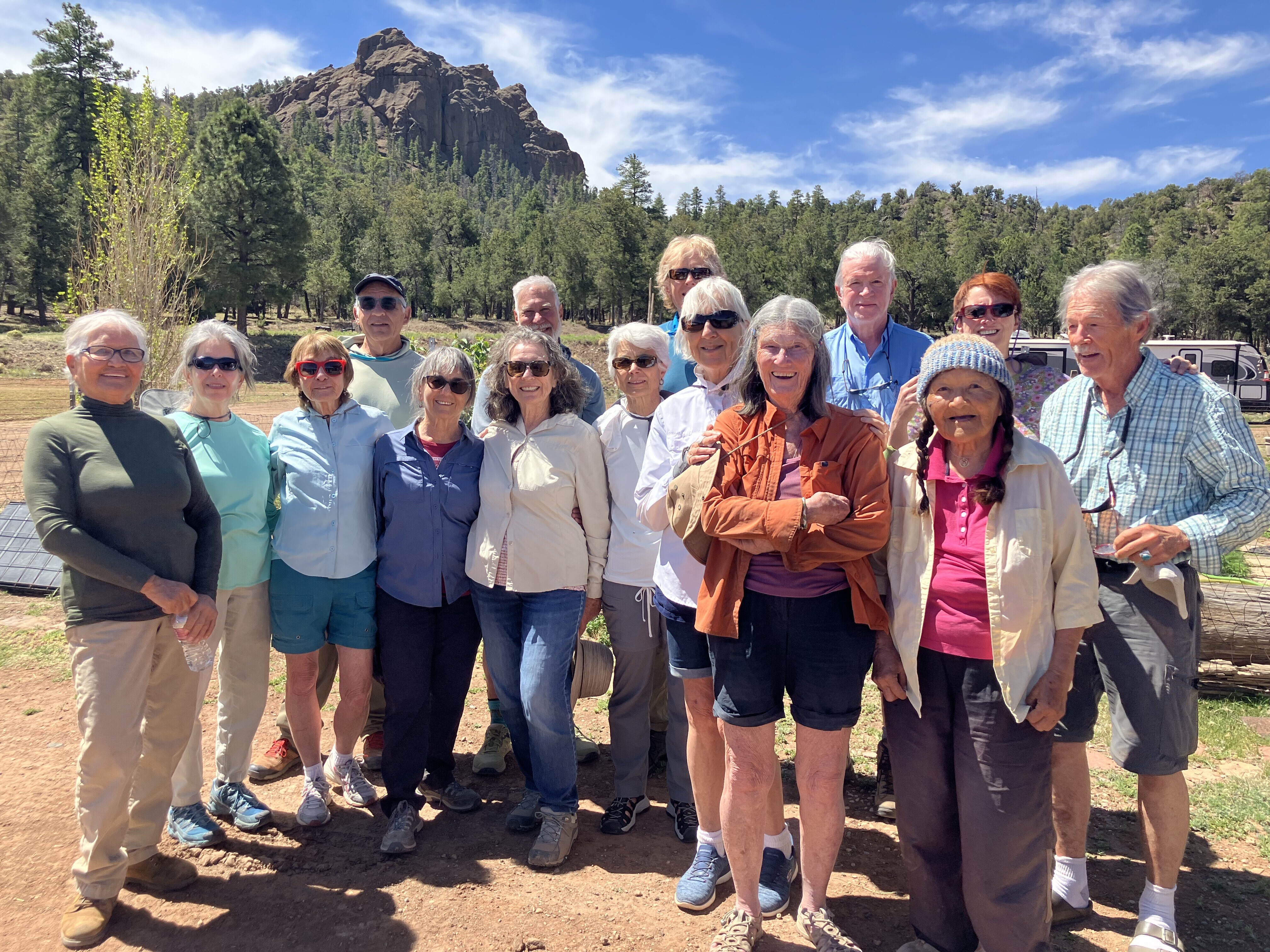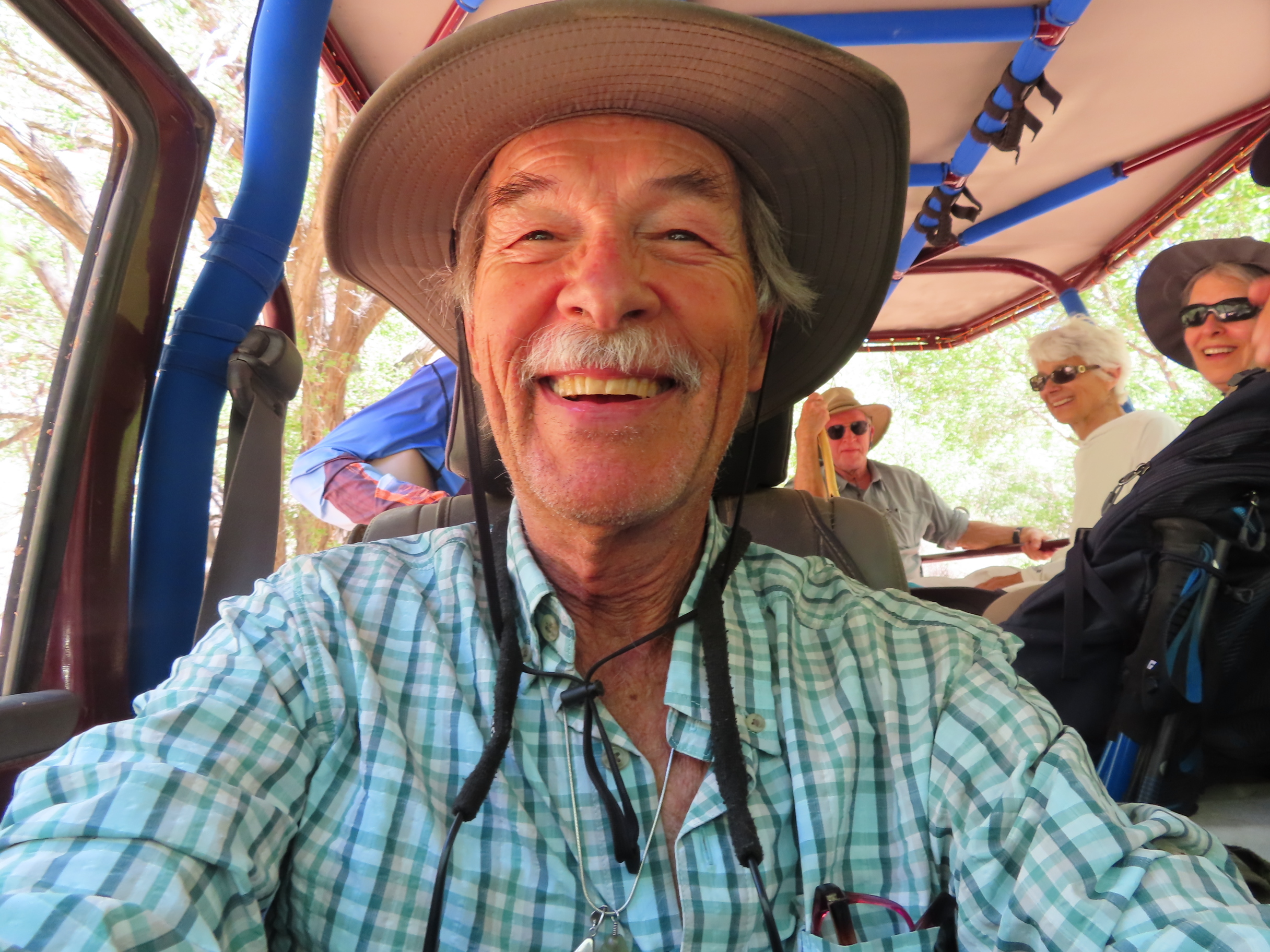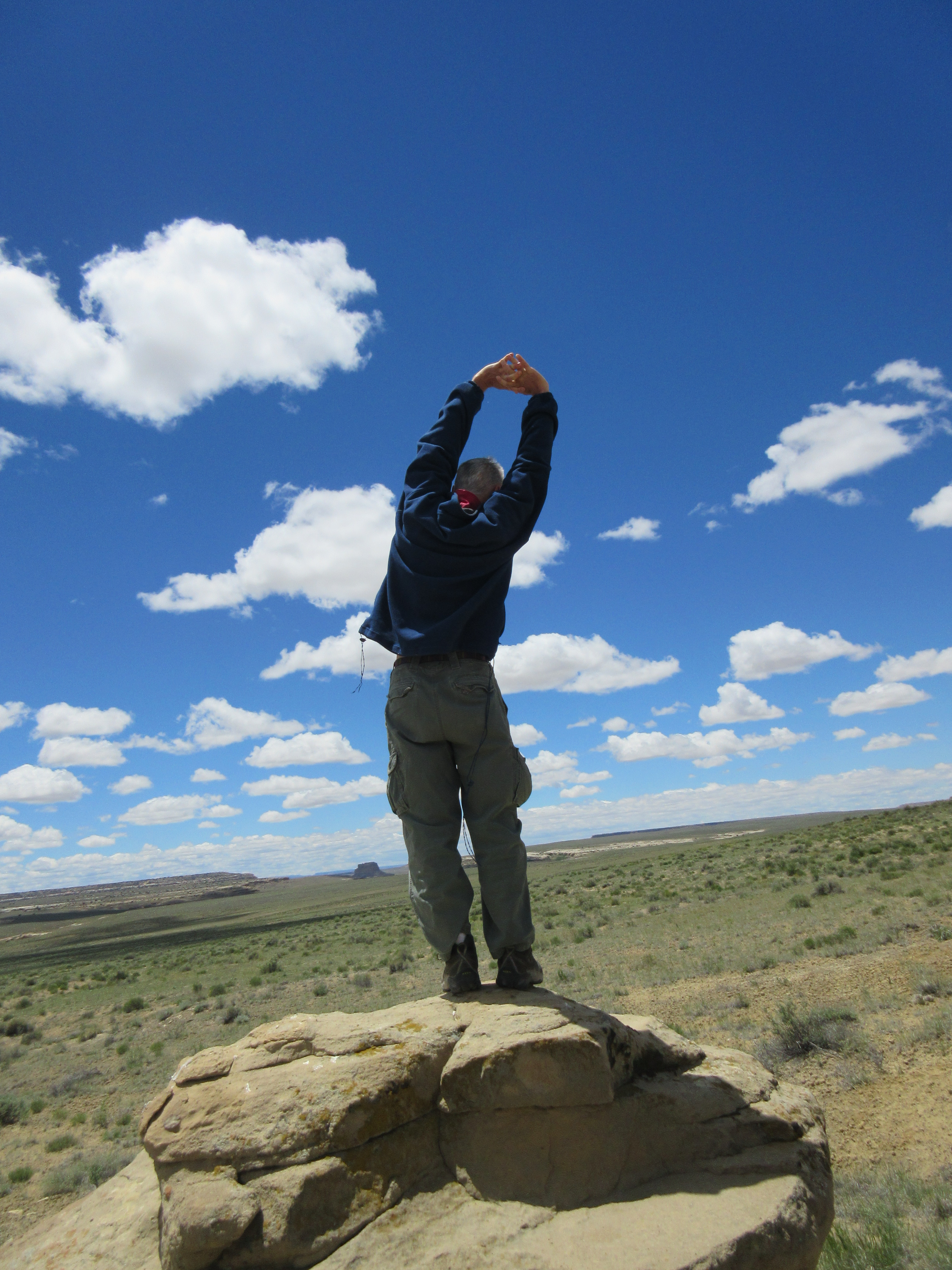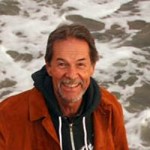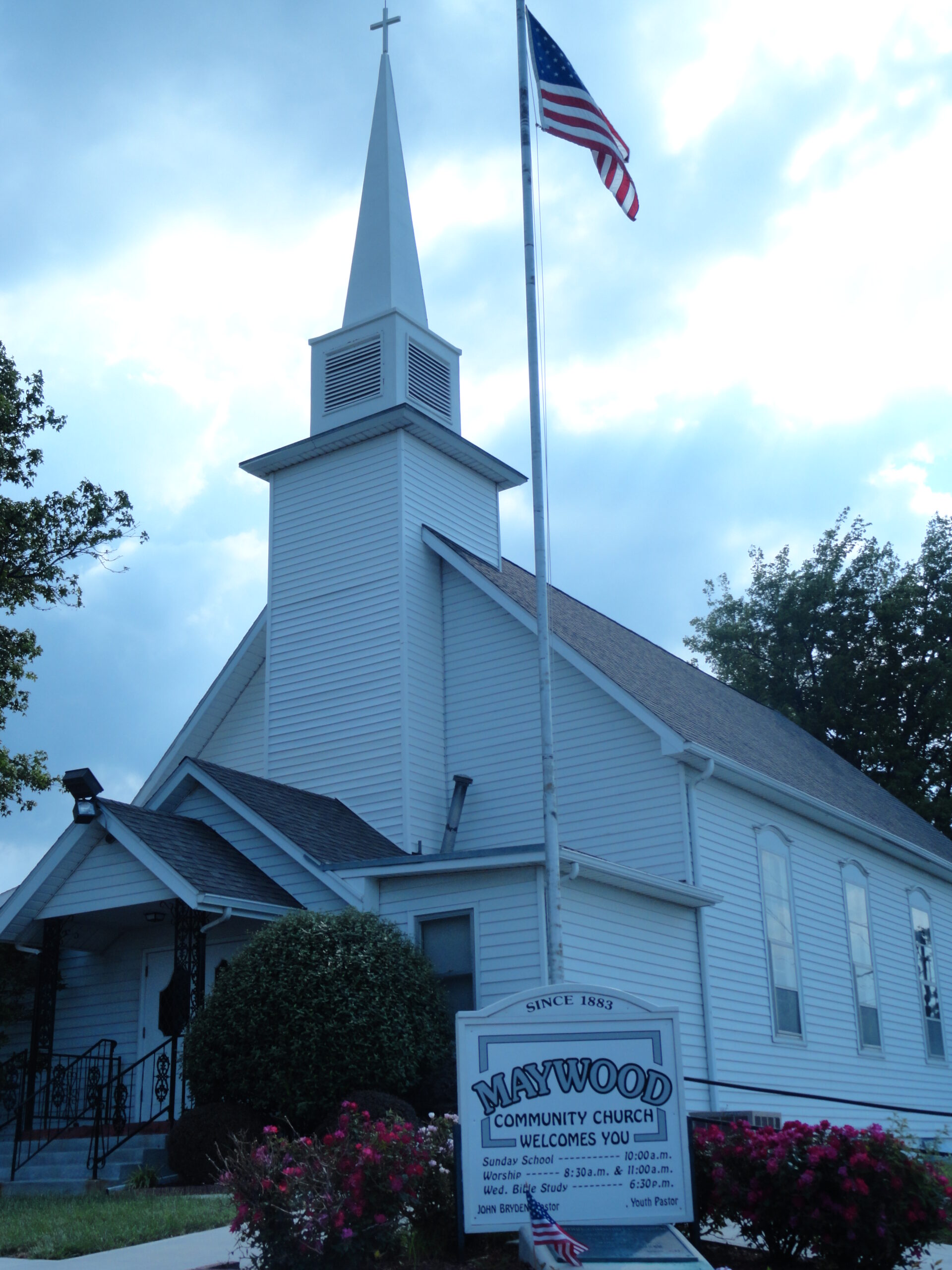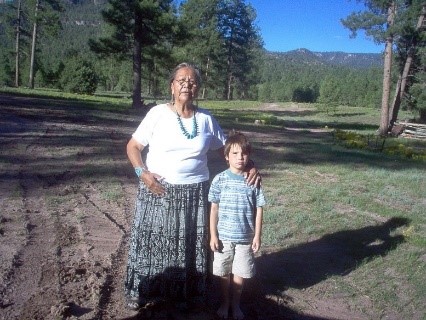Earth Walks In Canyon de Chelly 2025
A wonderful journey this May, 2025! On the way we stopped at the powerful volcanic formation called Shiprock.
Our local guides led us on a hike into the canyon and we stopped for lunch at Spider Rock, one of my places of personal reflection. One of our participants brought his large telescope for a Star Party on the rim of the canyon. Dine (Navajo) park ranger Justin shared the cultural cosmology of the stars, giving us a wonderful perspective. He is a runner and does so even in winter, drawing inspiration from the stars–as did we!Our last day was spent with friend Esther and her family at their ranch in Black Rock–and they all truly “rock”! Our thanks to them and so many others along the way. Plans are to return Memorial Day 2026–let me know if you would like to join the journey.
Happy Trails!
Doug Conwell
Chaco Canyon Journey 2024
The last day of our journey we walked in early morning silence up the path to Casa Rinconada, the Great Kiva. As we walked up, about 12 elk were walking down the mesa. One of those amazing sacred moments. At the kiva, we shared quiet moments of reflection and ceremony. Ines played her hand made buffalo drum, I played the Native American flute and Michael then intoned the haunting notes of his handpan. Then it was time to return, back to the campsite and back home after a wonderful experience together.
Come join us in 2025 when we return to Chaco…and maybe so will the elk!

Chaco Canyon Journey September 6-8, 2024
Come join us September 6-8, 2024 to experience the deep stillness and ancient voices of Chaco Canyon. Two night camping with all meals and guiding services provided (see more about the Earth Walks staff below). Time on your own in the Canyon as well.
Chaco Canyon, a major center of ancestral Pueblo culture between 850 and 1250, was a focus for ceremonial, trade and political activity. It is remarkable for its monumental public buildings and distinctive architecture, the most exceptional concentration of pueblos and ancient ruins north of Mexico. Chaco is a great mystery play whose actors are the stars, sun, moon, the land and imagination and spirit of those who 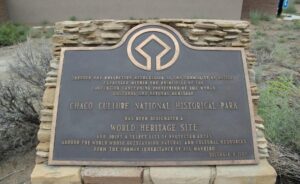 have made their way here over millennia. Both solar and lunar cycles were integrated into the architecture http://www.solsticeproject.org/lunarmark.htm and huge building sites were in alignment with each other over many miles. Great straight roads radiated out from the center of the canyon to distant outlying settlements. https://en.wikipedia.org/wiki/Archaeoastronomy#Chaco_Canyon
have made their way here over millennia. Both solar and lunar cycles were integrated into the architecture http://www.solsticeproject.org/lunarmark.htm and huge building sites were in alignment with each other over many miles. Great straight roads radiated out from the center of the canyon to distant outlying settlements. https://en.wikipedia.org/wiki/Archaeoastronomy#Chaco_Canyon
Many of the Indigenous people of the Southwest consider Chaco as their ancestral home and approach the canyon with the respect that one has for a wise elder in the family. I am one of the countless thousands who feel an inexplicable kinship here as well. Over the more than 30 years of personal visits and leading Earth Walks groups to Chaco, my experiences have been unexpected and surprising, healing and transformational.
 Earth Walks support staff, Sharon and Tina Guerrero, have Indigenous historical family roots in northern New Mexico and southern Colorado.
Earth Walks support staff, Sharon and Tina Guerrero, have Indigenous historical family roots in northern New Mexico and southern Colorado.
Sharon is a passionate advocate for our natural world as a long-time active member of the Sierra Club and Food and Water Watch. She has been supportive of cultural and social movements in New Mexico for many years working with local, state and federal governments. She is a Curandera and has studied with Michael Harner and Sandra Ingerman with the Institute of Shamanic Studies and sat in ceremony and led ceremony with Native Americans and people from all parts of the world. Having studied with NM Master Gardeners, she is currently coordinating an elementary school garden and teaching outdoor education classes.
Tina was trained as a Santa Fe Master Gardener and is a member and officer of the the Santa Fe Rose Society. She joyfully tends the roses in public gardens in Santa Fe and also volunteers in the Salazar School garden, raising fresh produce for local families. Professionally, Tina served as a fundraiser for universities and organizations, in Santa Fe, NM and across the country, including the National Sierra Club. Most recently, she worked for the Museum of Indian Arts and Culture as staff for the Museum of New Mexico Foundation. She has a degree in journalism, and an early prior background in the news industry.
Come Join Us on the Journey!
Cost: $535 Includes Earth Walks research, preparation and organization as well as guiding services; camping fees at the Canyon; all meals (lunch Friday through breakfast Sunday). Transportation by carpool. For more details contact info@earthwalks.org
HAPPY TRAILS, Doug Conwell
Making Friends with Wolf: The Beat Abides
It was a dark cloud covered night as I sat outside playing a drum at my Chupadero valley home north of Santa Fe in 1982. It was more like the drum was playing me–or we were in a conversation like close friends. 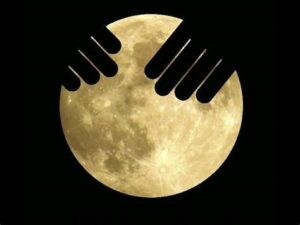 There was only the drum in my immediate awareness, no thoughts of conscious control or direction of the beat. A slight breeze began, then light rain. I asked whatever, whoever was listening in the darkness if I might see the moon and then watched how seemingly in response it appeared from a circular opening in the clouds. I kept drumming. A feeling of oneness with life welled up that was humbling amid this kinship with land, sky, water, air–an intimacy with the natural world I had not known fully before coming to New Mexico. The feeling was both new and anciently familiar.
There was only the drum in my immediate awareness, no thoughts of conscious control or direction of the beat. A slight breeze began, then light rain. I asked whatever, whoever was listening in the darkness if I might see the moon and then watched how seemingly in response it appeared from a circular opening in the clouds. I kept drumming. A feeling of oneness with life welled up that was humbling amid this kinship with land, sky, water, air–an intimacy with the natural world I had not known fully before coming to New Mexico. The feeling was both new and anciently familiar.
The beat abides.
Years later I learned that what happened this night in 1982 was the experience of many people in many cultures, this relationship of thought, intention and prayer between drummer, drum and the natural and noumenal world. Some say the drum was the first instrument used by humans and that it has the power to aid in healing and influence the weather. Stories about drummers being able to induce or dissuade thunder, rain and other elements through the vibrations sent into the atmosphere are common among indigenous people. https://www.youtube.com/watch?v=JPn6eZHhoo0
The Native American drum I held in my hands that night came to me through a creative performance production called Luna. I was singing as well as playing my old instrument from grade school, the clarinet. Friend Jim Berenholtz https://composers.com/composers/jim-berenholtz had composed the music and choreography for the performance based on the cycles of the moon. Singers, musicians and dancers from Taos, Santa Fe and Albuquerque joined the creative collaboration. After the performances, the one-sided Taos drums used by the dancers were for sale, and I bought one, not really knowing why or what to do with it. But the drum was calling me to listen to its voice–the language of the tree, the animal, the earth, ancient cultures of the world and my own heartbeat. Over time it has become an abiding companion on lonely nights, on Earth Walks journeys I have led throughout the American Southwest and Mexico and at monthly full moon drum circle gatherings in my home for over 20 years.
After living in Chupadero, I was fortunate to find a home in the Upper Canyon Road area of Santa Fe, near the national forest. 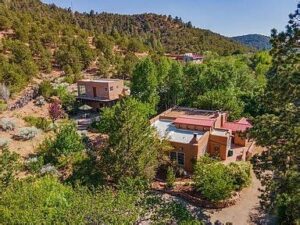 On a hot summer day in June 1989, I walked with friend Judy on the unpaved road from my house. Judy was and is a wise mentor and confidant and at the time a highly respected director of substance abuse programs in Santa Fe. Despite our easy-going conversation and smiles, I felt a certain sadness and slowness in my step because Judy was dealing with breast cancer. It was a huge ordeal for her, but even so she maintained a sense of hope and optimism. I wanted to help in whatever way I could, and had called her to offer a healing session with my drum.
On a hot summer day in June 1989, I walked with friend Judy on the unpaved road from my house. Judy was and is a wise mentor and confidant and at the time a highly respected director of substance abuse programs in Santa Fe. Despite our easy-going conversation and smiles, I felt a certain sadness and slowness in my step because Judy was dealing with breast cancer. It was a huge ordeal for her, but even so she maintained a sense of hope and optimism. I wanted to help in whatever way I could, and had called her to offer a healing session with my drum.
That may sound like I knew what I was doing with the drum. Yes, I had studied methods of healing through use of the drum with Michael Harner and other teachers and 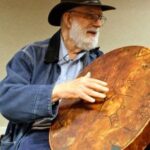 experienced what are called “journeys” to other states of consciousness where I encountered “animal allies” and insights into issues with which I was wrestling. The Way of the Shaman But to help someone else? I thought it over repeatedly and drummed on my own seeking guidance. Ultimately, I felt it would be worth a try to share this with Judy during her battle with cancer. She was open to the experience.
experienced what are called “journeys” to other states of consciousness where I encountered “animal allies” and insights into issues with which I was wrestling. The Way of the Shaman But to help someone else? I thought it over repeatedly and drummed on my own seeking guidance. Ultimately, I felt it would be worth a try to share this with Judy during her battle with cancer. She was open to the experience.
As we found our way to a secluded side canyon, there were a few drops of rain among Western meadowlark warbles and cooing Mourning doves. Judy got comfortable on the ground and I sat next to her, gently drumming. I closed my eyes, letting a rhythm emerge from within, without trying to construct one. What happened next are best described in Judy’s own words which she wrote in 2014:
“...friend Doug called and wanted to do a drum healing ceremony for me. He also played the flute, a hauntingly lovely sound heard years later as it wafted over us at my 50th birthday party, five years into survivorship. He does music; comforting and healing music, lodged firmly and deeply in his unique spiritual perspective and practice. On this June day in 1989, we walked into the Audubon protected area near his house on Upper Canyon Road. A meadowlark sang to us both as we entered the soft sunny woods, and again later as we left. I laid on my back in the sun as Doug gently drummed. As I slipped away, my hawk flew, circling above me and then came down to rest near me.
What seemed to be a snarling dull gray wolf was off to my right in the trees. I was afraid as it seemed ominous and scary. My hawk flew low and fast over me, I thought to protect me from the wolf. It then landed on the wolf’s back. I was no longer afraid, as the wolf now seemed friendly and non-threatening. The wolf walked over to me, hawk on its back, and wonder of wonders, stretched out soft and warm, nurturing along my left side, with its muzzle restring on my shoulder, sweet as can be. It was incredibly touching. The hawk then spread its wings and covered my body with them while resting on my stomach. I felt safe and embraced with healing light. I remembered another time in the early days of diagnosis, while visualizing the cancer, a snarling wolf had appeared and I pushed it away as it seemed frightening. Now it seemed like an ally; what had been frightening was now a helper. Extraordinary experience; extraordinary Doug.”
I do not consider myself extraordinary, but am humbled and grateful to Judy for this extraordinary opportunity. It was a healing experience that opened some unnamable healing currents within myself as well. Our experience was testimony to the power of the drum, the power of prayer and positive intention.
In the book “Black Elk Speaks,” by John Neihardt, Oglala Sioux holy man Black Elk says this: “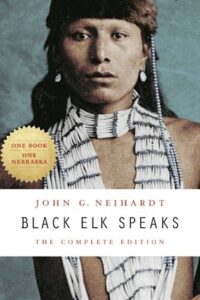 Since the drum is often the only instrument in our sacred rites, I should perhaps tell you here why it is especially sacred and important to us. It is because the round form of the drum represents the whole universe and its steady strong beat is the pules, the heart, throbbing at the center of the universe, it is the voice of Wakan Tanka (Great Spirit) and this sound stirs us and helps us to understand the mystery and power of all things.” https://www.nebraskapress.unl.edu/bison-books/9780803283916/
Since the drum is often the only instrument in our sacred rites, I should perhaps tell you here why it is especially sacred and important to us. It is because the round form of the drum represents the whole universe and its steady strong beat is the pules, the heart, throbbing at the center of the universe, it is the voice of Wakan Tanka (Great Spirit) and this sound stirs us and helps us to understand the mystery and power of all things.” https://www.nebraskapress.unl.edu/bison-books/9780803283916/
It is important to know that Judy was the victor in her battle with cancer. The beat abides.
Your Vibe Attracts Your Tribe–the Beat Abides!
In the beginning there was silence. Then came the big beat that some call the bang—intense vibration, energy, rhythm–sustained and steady. Since time began, that cosmic beat has remained through creation, war and turmoil, joy and transformation, chaos and dislocation–an ancient universal messenger keeping memory and hope alive across countless generations and cultures on Earth. And one beat of a drum opened a doorway of awareness for a young man who had just stepped out of the gates of incarceration.
It was 1998 and five of us were sitting around a low table in the little office space on Second Street that was assigned to a Santa Fe, New Mexico community corrections program. Three of the group were on probation from juvenile court. One of us was an Indigenous American woman named Sapokniona, White Feather Grandmother. One of us was me. All had drums in our hands. The faces of the two young men and one young woman on probation look bored or irritated and seemed to say, “OK, let’s get this over.” Sapokniona spoke gently, quietly, with what felt like reassuring confidence.https://sapokniona.wixsite.com/whitefeather
I had been asked to present some of my studies in cross cultural earth related traditions to these youth who were considered “high risk” having had numerous run-ins with the law. But when I got the go ahead, I puzzled about how to offer my experiences and studies to some who might not be remotely interested. I had a Master’s degree in criminal justice, had been a juvenile probation officer, worked part time in a Colorado youth prison and served a year as a counselor in an Army jail where the word “counselor” was an anathema, so I had some reason to wonder about what to present.
In the middle of my muddle came the thought: drums. Drumming was physical and could be energetic and noisy and an attention getter. Local drummer Eric Gent kindly loaned his drums. Eric and his wife Elise had sponsored African dance sessions in Santa Fe for decades. Then I thought of Sapokniona, an acquaintance of Apache heritage who led teaching circles, ceremony, workshops and retreats that included work with veterans’ groups. She kindly agreed to lead the group of youth that day.
“I want each of us to play one single beat, in unison,” Sapokniona said. I was expecting something a lot louder and more physical, but went along with it, as did the others. One beat at a time, like the steady rhythm of a pulsing heart. Each hand with a beater rising then falling on the face of the drum. First softer, then louder, then softer, then it was over. We went around the table to talk about the experience. It came to one young man who looked confused, withdrawn. He hesitated.
Finally, he said, “When I closed my eyes for a while, I saw a bear.”
“Well,” Sapokniona paused, then responded. “My people believe that the bear represents the direction of the west. And you are sitting in that direction. I’m not surprised.” But the rest of us were, including the young man whose face lightened a bit, almost into a smile.
The beat abides—your vibe attracts your tribe.
To my understanding, some Indigenous Americans view the strength of “bear medicine” as the power of introspection. Bear seeks honey, like the sweetness of truth and intuition inside the silent “cave” of mind and soul. Think of Merlin in his crystal cave. In India, the cave symbolizes the creative energy of Brahma which some consider to be the pineal gland located at the base of the brain. https://study.com/academy/lesson/god-brahma-overview-facts-significance.html
As I wrote these words on an early March morning in 2017, the first rays of sun touched my table, the computer, my hands, the photographs of the family “rogue’s gallery” above on the wall. I stopped for a moment to listen to the “sounds of silence” around me: the light twinkle of water in the nearby fountain, the low burbling beating of the humidifier releasing wispy curls of steam, the drone of the refrigerator, the rumbling beat of the attic heater and then…the percussive tapping of typing on the laptop with punctuations, rests, faster and slower rhythms…an opus magnum.
I thought again about the young man in the drum circle who had just stepped through the gates of incarceration. Something happened for him that day that couldn’t be put into words. His eyes got a little wider and there was something like a smile. Maybe the world, too, got just a bit wider with wonder and possibility for him and for all of us in the group, drumming that one beat together.
Did it make a lasting difference in his life in some way? I don’t know. But my thought and hope echo Ann Mortifee’s song, “Just One Voice” https://www.youtube.com/watch?v=U_xixpmvgGY
A single note becomes a song,
A single tree becomes a forest.
A single voice that’s clear and strong
Can turn into a worldwide chorus.
Just one voice, one single voice,
If you say you can, well then you can!
The Native American drum first found its way into my hands in 1982 soon after I arrived in New Mexico. It still does in 2024 after hosting monthly full moon leaderless drum circles in my home for nearly 25 years. In the posts to follow, I’ll share some of my journey with the drum. If you haven’t picked up a drum to try it out, do so! It’s a universal, worldwide instrument. Your vibe will attract your tribe. Have fun!
A Voice in the Clouds
It was an overcast day, the gray clouds mirroring my mood from the news I had just received early that morning. My mother called from Kansas to tell me that her father, Grandpa Wallace Fleming, had just passed on. As I lay in bed gazing out the window at the colorless clouds thinking of him, a perfectly circular opening appeared in the gloom through which I could see brilliant blue sky. At that moment I seemed to hear grandpa speaking to me and telling me he had “made it over” and all was well.
It was March, 1978 and I was living in Boulder, Colorado serving as a juvenile probation officer and working on my Master’s degree in Public Administration with specialization in criminal justice. In August of 1981 after I moved to New Mexico, I visited the Millicent Rogers Museum in Taos which had an impressive collection of Native American and Hispanic art and artifacts. https://www.millicentrogers.org/pages/mission
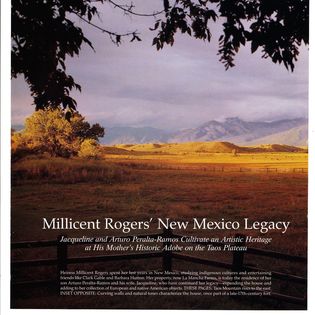 I was drawn to a particular Hopi pot and discovered quite to my surprise a depiction of what were said were “spirit holes”–circular openings in the clouds through which the spirits pass through. In total amazement, I realized that my personal experience was not singular and indeed was confirmed by at least one other culture, in this case the Hopi Pueblo people of Arizona.
I was drawn to a particular Hopi pot and discovered quite to my surprise a depiction of what were said were “spirit holes”–circular openings in the clouds through which the spirits pass through. In total amazement, I realized that my personal experience was not singular and indeed was confirmed by at least one other culture, in this case the Hopi Pueblo people of Arizona.
From a strictly meteorological point of view, there are some possible scientific explanations: https://www.weather.gov/grb/111506_holepunch https://spectrumlocalnews.com/nys/central-ny/weather/2020/11/25/what-is-a-hole-punch-cloud and https://en.wikipedia.org/wiki/Fallstreak_hole I have been told by Indigenous Pueblo people where I live in New Mexico that they traditionally believe moisture from the clouds in the form of rain, snow, etc. is the ancestors coming to visit. If you think about it, when we pass on, the moisture which comprises nearly 70% of the adult human body, evaporates into the atmosphere and to some degree becomes part of the life cycle that includes the formation of clouds. Maybe that “some degree” also carries the voice and spirit of the ancestors.
In any case, that day in Boulder I am certain the voice and spirit of my own ancestor Grandpa Fleming spoke through the perfect circle in the clouds, letting me know he’d made a happy landing.
Rain Caller
RAIN CALLER
Sometimes you do what you need to do without knowing what you need to do. That was the case on a blisteringly hot summer day in Santa Fe in 1995. Temperatures were over 100 and we had been suffering from a long dry spell with no relief in sight. Not a single cloud in the sky for weeks. It was part of an unprecedented heat wave in midwestern U.S. states during which 3,000 people died, 750 in Chicago alone. https://press.uchicago.edu/Misc/Chicago/443213in.html
I was living at 1710 Upper Canyon Road in an historic but crumbling adobe rental that had all the rough charm I could have ever wanted. The first Archbishop of Santa Fe, Lamy, was listed as the original property owner, but the rugged remoteness of the earthen cabin two miles from the downtown Cathedral might have made the place more of a retreat house than a primary residence. The fireplace was almost big enough to put whole trees in it, or so it seemed to me. There were cracks in the wood plank flooring and cracks around the weathered window frames where the adobe plaster was splintering. One day as I sat at the kitchen table with my dear black cat Mona on my lap, a chunk of wall fell out, hitting me on the forehead and narrowly missing Mona. As I sat motionless and stunned, a small dribble of blood began to snake down my face. (The photo above is from a realtor’s page after the little adobe I lived in was bought and expanded dramatically.)
But I loved the place, and it loved me back. It was a dream come true–living by an acequia (irrigation canal) next to the Santa Fe National Forest, dark night skies filled with an amazing quilt of sparkling stars and quiet. Many gatherings of friends and welcome strangers took place there over the years–drum circles, counseling and massage therapy sessions, music making, tipi ceremonies and prayers for peace and well-being. The adobe walls were thick and on hot days, a welcome relief to the relentless sun and heat outside. On cold days it was hard to stay warm even though I covered the widows with thick plastic sheeting and fashioned my Grandma Fleming’s wool blankets into curtains.
On this particular day I had agreed to give a massage to an NMAS client who was now at my door. I was a volunteer massage therapist for the New Mexico AIDS Services program, serving people with HIV and AIDS as well as their caregivers and families. Before starting the session, I said to my client, “Rocky, I feel like I need to go outside and call the rain.” He looked at me puzzledly but joined me on the patio. “What are we supposed to do?” he asked. I had no idea, but I did bring what is called a “rainstick,” thinking that might help in some way.
A rainstick is a long, hollow tube partially filled with small pebbles or beans that has small pins or thorns arranged on its inside surface. https://en.wikipedia.org/wiki/Rainstick When the stick is upended, the pebbles fall to the other end of the tube, making a sound reminiscent of rain falling. The rainstick is believed to have been invented by the Mapuches of Chile and was played in the belief it could bring about rainstorms. It was also found on the Chilean coasts, though it is not certain if it was made by the Incas. Rainsticks are usually made from any of several species of cactus. The cacti, which are hollow, are dried in the sun. The spines are removed, then driven into the cactus like nails. Pebbles or other small objects are placed inside the rainstick, and the ends are sealed. A sound like falling water is made when the rainstick has its direction changed to a vertical position. Although it was thought to have been invented in Chile, many similar instruments can also be found in Southeast Asia, Australia and Africa, where it is often made using bamboo rather than dried cactus. Indigenous peoples of the Southwest use gourd rattles and other instruments in a similar ceremonial fashion.
For some reason, I lifted my rain stick to the sky and turned it to face the full intensity of the sun. As I turned the stick, pebbles gently creating the sound of water flowing, I asked the sun for its help in bringing rain. Pretty counter intuitive it seemed. It was Rocky’s turn to do what he thought best, then we both went inside for the therapy session.
Just as we began the massage, I thought I saw a brief dimming of light outdoors. Then again. I looked and there were a few clouds, the first in many weeks. That evening there was a wonderful rainstorm bringing much needed relief. Needless to say, I was dancing in the rain for joy.
Some days later, I spoke to a Dinè (Navajo) elder friend by phone. Annie Kahn had hosted a number of Earth Walks journeys at her hogan in Lukachukai, Arizona and I had great respect and love for this dear person who shared her wisdom with so many others.
“Annie, do you think I kind of maybe smelled or sensed the rain coming that caused me to go outside and do the rain prayer?” I asked.
I could see her shaking her finger at me in her good-natured grandmotherly way. “It sounds like you are having trouble accepting responsibility for what you did. More people should be doing this!”
Ladder to the Moon
It was a hot summer solstice day June 22, 1985, and I was hiking the high country above Santa Fe with a 40-pound backpack. Light streamed through ponderosa pines, dappling the path I walked. My breath was coming harder so a stream along the way was welcome cool relief. Then it was onward and upward.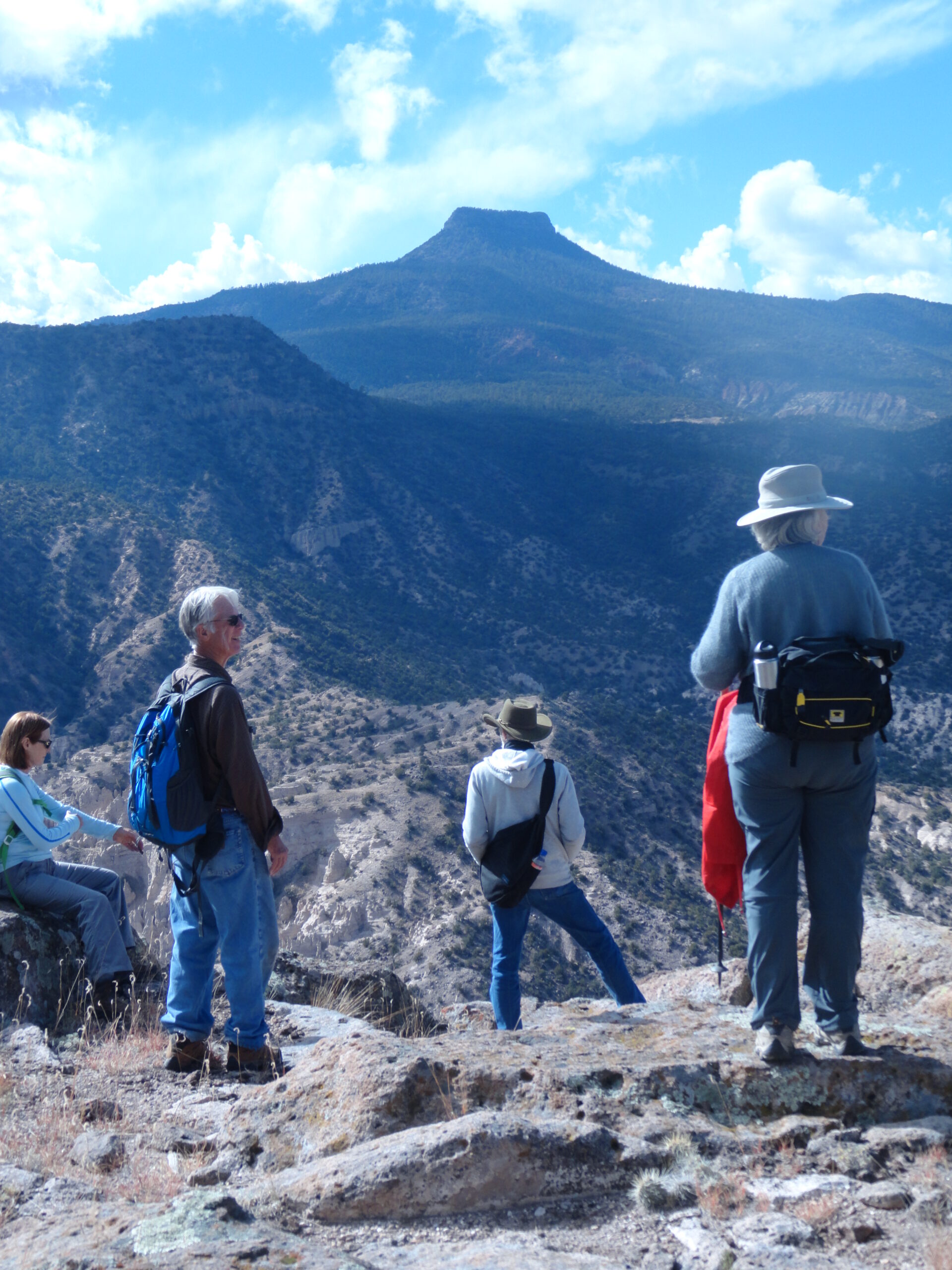 As I approached the summit of Puerto Nambe, I paused for air in the rarefied atmosphere and took in the great expanse nearly 12,000 feet below me. I felt small, insignificant amidst this vast panorama and yet somehow as wide and endless as the sky and its horizon. Far in the distance was Pedernal Peak on the northwest edge of the Jemez Mountain range.
As I approached the summit of Puerto Nambe, I paused for air in the rarefied atmosphere and took in the great expanse nearly 12,000 feet below me. I felt small, insignificant amidst this vast panorama and yet somehow as wide and endless as the sky and its horizon. Far in the distance was Pedernal Peak on the northwest edge of the Jemez Mountain range.
Pedernal in Spanish means “flint.” The first peoples of the area call it by the Keres language name of Tsi Ping, “place of chipping away.” Centuries ago, Pueblo people traded chert and obsidian implements crafted from mines at Tsi Ping. When I once climbed the 10,000-foot volcanic butte, I was scrambling up 8 million years of geologic history and could see the far away mountains of Colorado. Another time I explored the nearby ancient pueblo (also called Tsi Ping) perched atop a mesa and found numerous examples of archeoastronomy, places where researchers believe certain natural features align on specific seasonal, lunar and solar events and figure into sacred ritual observances of the people. As they continue do today in the Pueblos, these cyclical events foster awareness of our essential connection with nature and a sense of balance and inspiration. https://geoinfo.nmt.edu/tour/landmarks/cerro_pedernal/home.html
Silently standing on the summit of the Sangre de Cristos and looking back at Tsi Ping, I was awestruck at the drama of sky and earth before me. I was certainly not the only one to feel that way. In 1958, famed artist Georgia O’Keefe painted Tsi Ping with a ladder to a moon suspended in a turquoise sky. The moon was in perfect balance, halfway between full and new, light slicing it exactly in half. They say Georgia thought if she painted it enough times it would become “hers.” Was the painting just a reflection of surroundings at her Ghost Ranch house? Or did it symbolize some kind of unseen link between us and cosmic forces like the ladder in a sacred ceremonial Pueblo kiva? We can only guess at the answer, but O’Keefe passed on March 6, 1986 and her ashes were spread atop the peak according to her wishes. If the mountain did not become hers, perhaps she was claimed by the mountain. https://www.georgiaokeeffe.net/
O’Keefe was a fearless pioneer when women were more likely to be found cooking in the kitchen and cleaning up after their families. That’s a sacred role, but O’Keefe was an iconoclastic renegade, a rebel with a cause and a profoundly talented one at that. I’m a lot rebel myself and I like that in her. She also took a local young man, Tio Manzanares, under her wing and supported his education and employment. Tio later became a friend of mine as well as an Earth Walks cultural guide. O’Keefe gave generously to the local elementary school and other causes.
It was getting late that summer solstice afternoon, and I needed to make camp in the Puerto Nambe area. But I was glued in astonishment to the rock in the meadow where I sat watching the path of the sun make a direct arc towards the dark pyramid of Tsi Ping. As it reached the horizon the huge burning orb of orange and red set directly behind the pointed peak, bisecting it exactly in half. Had I been here a few days before or after, I would not have seen this phenomenon. In that profound instant, dots and lines connect in my mind.
There are no accidents. I was watching this convergence of sun and earth that in my bones I knew was a part of ancient rituals at this very spot. I had not only a visual connection with Tsi Ping at that moment, but something else powerful, unnamable, timeless. The sun set and I had to set up my camp for the night. Hoisting up my backpack I walked the steep mountain pass trail into the growing darkness of evening, like walking up the steps of Georgia’s ladder to the sky. Somewhere above me that moon must have been hanging in perfect balance.
I Shine Not Burn
“If you leave the journey exactly who you were before you departed, the trip has been much wasted, even if it was just to the Quickie Mart.”–William Least Heat Moon, “Roads to Quoz”
It was a lonely stretch of New Mexico state road where I left the car that late summer day in 1981. Not a cloud in the deep brilliant blue sky. Making my way to the barbed wire fence, with great difficulty I shoved my heavy backpack over, then crawled under the fence onto BLM land. The powerful presence of Bear Mountain loomed above me, but I took a deep breath before I set out to ascend this singular volcanic dome north of Tres Piedras near the Colorado border.
Of all the ethnic family strands, it’s the McKenzie Klan of the Scottish Highlands with whom I feel closest kinship. In the only real picture I have of him, grandpa has a serious countenance and a full white beard that extends to the middle of his chest. I don’t know if he had a sense of humor, but he had a sense of purpose that I like. I imagine him to be a bit dour and highly principled with a sense of responsibility to family and community. He was a decorated Civil War veteran for the Union and a leader. Who knows? Maybe he had a secret life as a fancy dancer! Years ago, my mother gave me his “Gunn’s Family Physician,” a thick tome of the time on health and healing for body mind and spirit. I have traced his hand written notes with my own hand and use the book as a reference for health matters. Just so happens I became a massage therapist and have an ongoing interest in preventive health care. Feels like a lot of Grandpa McKenzie lives on in me.
The first thing I moved into my Santa Fe home where I’ve lived for over 20 years at this writing, was an eight-foot-tall secretary desk grandpa crafted from walnut trees on his farm. He built two large houses mostly by himself, and the desk gives me a sense of continuity, confidence and practical skills, like taking steps up a tall ladder with someone securely holding it in place at the bottom. When refinishing the desk, my father found a picture of Abraham Lincoln, President at the time, pasted onto the desk. Every time I dust that desk, I touch the past and shake hands with my family. One aspect of history not mentioned, though, is that like most places in this country, grandpa’s farm and the trees he fashioned into homes were on Indigenous land that was originally taken by hook or by crook. Whether grandpa ever acknowledged this or offered his respect is lost to history. Even President Lincoln, honored in so many ways, was sadly responsible for the forced removal of Indigenous Americans from their homes and turned a blind eye to horrific treatment of Native people. https://www.history.com/news/abraham-lincoln-native-americans
The path up the 2,000-foot Bear Mountain (called San Antonio on the map) was non-existent. I laboriously traversed up sharp-edged basalt, loose boulders, rubble and vertical terrain. It was slow, arduous going and early on I got tired and frustrated with a heavy pack on my back. Halfway up I noticed a huge black bank of thunderstorm clouds fast approaching from the west. The wind picked up and I started to worry about being caught on the mountainside in rain and lightning. I increased my pace and also increased my level of impatience at the slow going which was much slower than that of the oncoming storm. As the wind whipped more fiercely, I lashed out with the cane at plants and objects “in my way.” Some part of my mind was well aware that I should not be using grandpa’s walking stick in such an angry way.
Finally, I made my way through the scrub oak and Ponderosa pines to Douglas fir and shimmering aspens at the top of the mountain. Quickly making camp and setting up the tent, I waited for the big storm–which never arrived. All that fussing and furious fuming for nothing. It struck me as ironic that our McKenzie Klan emblem, flames shooting from the top of a mountain, mirrored my emotions at the time, because I’d been burning up with impatience on the difficult ascent. Here I was on top of a mountain that millions of years ago was molten red hot, no doubt with flames shooting out in every direction. If I had only remembered the McKenzie Klan motto: “I shine not burn,” (Luceo Non Uro) I might have taken a breath, paused and continued at a more reasonable pace.
I set up the tent and made camp for the night. But later in the darkness I awakened to sounds of footsteps and was frozen with anxiety. It seemed like a two footed being, but I was not sure. Bear? Deer? Cougar? Human? Slowly the footsteps circled the tent with me inside not knowing what the next step might bring. Silently I heaved a sigh of relief as the next steps were away from the tent until I could no longer hear them.
In the morning when I packed to leave, Grandpa McKenzie’s walking stick was nowhere to be found. Could it somehow have been taken out of my hands for misusing it when I was angrily hacking at plants in my way on the furious ascent? Was it the mysterious being in the night that took it away? Whatever. Sadly, and slowly, I loaded up the backpack and walked away from the site for the return home. But then there was a voice in my mind. Where do these things come from in our head, these unbidden words seemingly out of nowhere like a telemarketer on the phone or an unsolicited email? Quièn sabes, but the voice was there, telling me to “Remember to thank the place where you have been!” Following this good advice, I turned around to do so and there, on the ground at my feet–the walking stick! Funny thing though. Years later I discovered that I could have easily driven my car on a gravel road nearly to the top of the mountain. I am glad I didn’t.
Roshi Joan Halifax in her book “The Fruitful Darkness: A Journey Through Buddhist Practice and Tribal Wisdom” (Grove Press; 1st Grove Press Ed edition (March 15, 2004) relates a question she asked of Zentatsu Richard Baker: “Roshi,” she asked, “there is the path to the temple and there is the temple. What is the meaning of the path?” His answer: “Joan, the path IS the temple.” I get that. Without my emotional and physical struggle up Bear Mountain I might not have been given the teaching on the summit. Now, for me the cardinal direction of the north is where I remember my ancestors, especially Grandpa McKenzie. And the teaching? To always thank the people and places I live and visit in life’s journey–my individual earth walk. And another message from the mountain: “to shine not burn.”
Maybe that’s a message trying its best to get through to me all my life. I have this distinct memory from about age six of being in my parents’ basement on Krameria Street in Denver, sitting in the dark and lighting a candle. The memory literally burned itself into my mind when like a moth drawn to the flame my little self-bent forward too closely, staring into the flickering luminosity and singed my eyebrows. Guess I could have singed more than that since my older brother Gary now tells me that his bedroom was in the basement.
As I grew older, the little moth of my mind kept fluttering towards the light, sometimes nearly consumed in the flames. In my hippie days in undergraduate school, we’d usually light a candle as part of the ritual involving the illicit cannabis. One of my close friends during these flights of fancy said she thought lighting a candle was like letting a little bit of God in the room. That stuck, though the use of cannabis did not.
It was the Vietnam War era in the late 1960s and I was feeling schizophrenic. Maybe not clinically, but one day I was dressed in ROTC military uniform, marching on the college playing fields, trying to act like a little soldier. The next day, I was marching in the streets against the war. What was wrong with this picture? Then came officers’ basic summer camp in 1970 at Ft. Sill, Oklahoma. At the beginning of training, we were warned repeatedly, “Don’t touch the barrel of the weapon you have been using. It will burn your hand.” Good advice, but what I call my “angel guides” had me do exactly that, so I did indeed burn my hand severely and couldn’t train with a weapon for a while. Another one of those unbidden messages telling me to seriously consider what the heck I was doing.
I actually don’t remember much else about summer camp, probably because I want to blot out that distressing time in my life. My senior year in college I went through agonizing soul searching, counseling, lots of lit candles, the news about National Guard killing of anti-war student protesters at Kent State University in Ohio and the My Lai massacre of Vietnamese civilians by US soldiers. My final decision was to “shine and not burn” in this terribly wrong military conflict. I applied successfully for noncombatant status, which meant I was denied the officer’s commission and subjected to the draft. Ultimately, I was drafted and served two years in the Medical Service Corps, facing some hellish situations. But that’s another story.
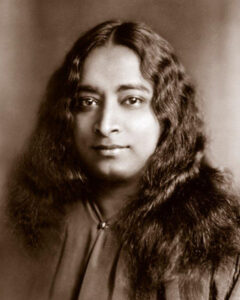 In later years I discovered the teachings of a wise East Indian avatar, Paramahansa Yogananda. In a book called “Man’s Eternal Quest” he wrote:
In later years I discovered the teachings of a wise East Indian avatar, Paramahansa Yogananda. In a book called “Man’s Eternal Quest” he wrote:
…You cannot make steel until you have made the iron white-hot in the fire. It is not meant for harm. Troubles and disease have a lesson for us. Our painful experiences are not meant to destroy us, but to burn out our dross, to hurry us back Home. No one is more anxious for our release than God.
After the Army I headed back to my hometown of Denver, Colorado. But fire seemed to follow me wherever I went, or maybe I followed it. One surprise birthday party at a friend’s home, I got the call that the fire department was scraping the remains out the window of my rental home in the Cherry Creek area. Faulty wiring had shorted out an electric blanket on my bed. One good thing about the fire though: the gold polyester wide lapel leisure suit my parents had given me melted. I never did like that goofy looking thing.
Work and graduate studies at the University of Colorado took me to Boulder. That went pretty well but the green bubble of Boulder was surrounded by the front range “brown cloud” air pollution in the Denver area. It was a dry summer and thick smoke from fires in the foothills added to the poor air quality. I thought I had returned to my hometown after the Army, but it had been swallowed up by rampant urban growth we humorously called “Californication.” I felt pushed out of the area, but I also felt a pull to New Mexico.
So, Mona my cat and I packed up and moved to Santa Fe in 1978 and after several years found a wonderful old crumbling adobe duplex rental on Upper Canyon Road that at one time had been in the hands of the first Santa Fe Archbishop, a Frenchman named Lamy. But unwelcome fire continued to follow me. One day I came home to find the foam rubber plug to my fireplace melted and a large pillow sitting in front of it on slow burn, headed to the 150-year-old wooden plank floor. Years later when I was teaching my “Earth Walks: The Spirit of Place” class at Ghost Ranch Education and Retreat Center north of Santa Fe, I came into my classroom to find the fireplace mantel smoldering, somehow lit from my incense sticks. Hmmmmm….was there a pattern going on here? Burning, not shining like the McKenzie Klan motto advises.
It wasn’t all hell fire and brimstone, though. Along the way I started picking up clues to fire being a way to burn out my “dross” and help me hurry back “home.” Sunday night fires in the Ben Franklin stove had been a family tradition growing up, along with popcorn and hot chocolate, us boys polishing shoes for the school week ahead and watching our favorite TV shows–Gary Moore, I’ve Got a Secret, Gunsmoke and Bonanza, To Tell the Truth, the Carol Burnett Show…and all the rest.
Now in New Mexico, Sunday nights have become my own tradition. Popcorn and hot chocolate for sure, but no more shoe polishing. The longer I lived in Santa Fe the more I found fire to be an essential element of my consciousness. The McKenzie Klan symbol is “fire on the mountain,” but there haven’t been volcanoes in Scotland for millions of years. Near Santa Fe, however, is a recently active region of big-time eruptions and magma flows. The largest man made “fire”–the atomic bomb–was developed just 30 miles away and tested in the southern part of the state. Talk about the need to “shine, not burn!”
Along the way in Santa Fe, I met Concha Garcia Allen, elder member of the Mexican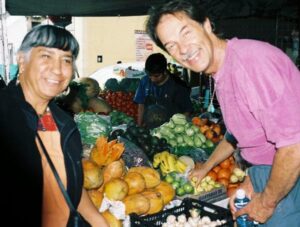 Danza Azteca ceremonial prayer group. She introduced me to “Tatewari” or Grandfather Fire in the native Huichol tradition. Tatewari represents–actually becomes–a breathing, speaking elemental force which empowers a person to follow her heart path to completion. For me this age-old shamanic practice made complete sense as I began to weave the threads of my own Scottish highland Fire Klan heritage. On Earth Walk journeys in Canyon de Chelly, Dinè guide Daniel also spoke with Tatewari, although by another name, in the embers of our campfire divining meaning and messages for those willing to listen.
Danza Azteca ceremonial prayer group. She introduced me to “Tatewari” or Grandfather Fire in the native Huichol tradition. Tatewari represents–actually becomes–a breathing, speaking elemental force which empowers a person to follow her heart path to completion. For me this age-old shamanic practice made complete sense as I began to weave the threads of my own Scottish highland Fire Klan heritage. On Earth Walk journeys in Canyon de Chelly, Dinè guide Daniel also spoke with Tatewari, although by another name, in the embers of our campfire divining meaning and messages for those willing to listen.
In 1993 leading a small group of people to Oaxaca, Mexico for Dia de los Muertos (Day of the Dead) I discovered the ancient Mexican god of the fire and brought a weaving of the image back home where it hangs above my bed in all its fiery composure. That same year I traveled to the home of Annie Kahn, Dinè elder and teacher, for a visit and sweat lodge. Sadly, the lodge had been burned down by arsonists just prior to our arrival. Annie sent family members into the nearby mountains to gather the proper plant materials to do ceremony and prayer. As soon as possible, we all pitched in to help rebuild the sweat. This, Annie said, was essential.
“Never let something bad happen without making it right as soon as you can,” she explained. “Don’t let the bad thing fester.” That was good advice to me who tends to perseverate and stew over sometimes the smallest things.
Ten years later in 2005 and half a world away, I was floating in a boat on the sacred Ganges River fascinated by flames of the Indian Hindu “Aarti” ceremony. It was night and the waters of the great river in front of us reflected and intensified what we saw on the shore. Brahman priests clad in saffron colored robes chanted continuously, circling multi-tiered butter lamps in great arcs around their heads, ringing bells and chimes and intoning ancient prayers. It had been this way for centuries and though my traveling companions and I were tourists, the power of the ceremony was anciently familiar in my Scottish Fire Klan bones.
This was not the only flame I saw while in India. Days later our group visited Bodh Gaya, the site where it is said that Siddhartha Gautama, the spiritual teacher who later became known as the Buddha, is said to have attained enlightenment. An offshoot of the original venerable “peepal” or fig tree under which he attained this state of consciousness now grows next to the large temple erected in his honor. https://en.wikipedia.org/wiki/Bodhi_Tree
As I knelt at the steps in front of the tree and bowed to honor the Buddha, my head bonked on the stones so hard that I thought it must have been audible to those around me. Immediately amidst the ringing in my ears I heard in a loud exclamation: “Awaken!” Funny thing, one of our tour leaders, Annette, told me later she had the same exact experience. I wonder what spiritual Youtube channel we both were plugged into?
Returning to the scene of the head bonk that evening, thousands of pilgrims were circumnavigating the temple, prostrating themselves on the sidewalk every few feet. Over the loudspeakers a continuous droning chant was taking place. But I found the low bass tones irritating and was hoping the group of younger monks in front of me were next in line to chant, hopefully with a more baritone. I sat opposite the group, taking it all in—the crush of the crowd, the droning basses, the intense spiritual fervor and me, just sitting there quietly watching. For a moment there was a parting of the crowd and gazing across at the seated group of monks, I was astonished at what I saw: a large flame inexplicably suspended in midair above them. The crowd crushed in again, then again briefly parted. The flame was gone.
But not gone from my consciousness. The flame was as real as the nose on my face and blazed its image into my mind. I had to find out what it meant. Once back in New Mexico, my search uncovered a rich and complex symbolism for the flame across cultures and traditions. The Christian view sums it up for me: the Holy Spirit. Kinda gives a new light–so to speak–on popcorn, hot chocolate and my Sunday night winter fires. I keep lighting those fires and also lighting a single candle each evening that glows throughout the night. It’s a way to remember the message of Bear Mountain and the counsel of my McKenzie Klan to “shine not burn” as I continue on my earth walk this lifetime. (For worldwide meaning of the sacred flame: https://www.ancient-origins.net/myths-legends/fire-symbolism-flames-ignite-faiths-and-inspire-minds-004404 From this website, the following picture.)

